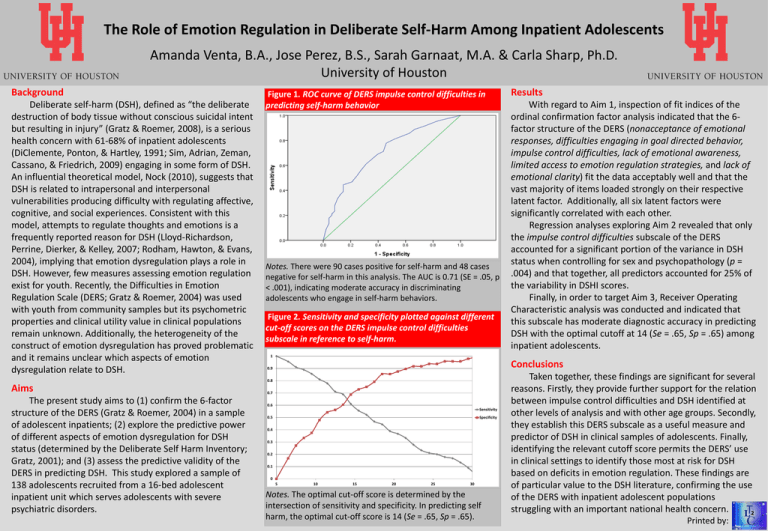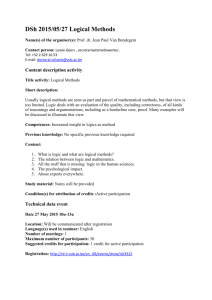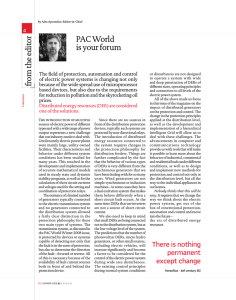The Role of Emotion Regulation in Deliberate Self-Harm Among Inpatient... Amanda Venta, B.A., Jose Perez, B.S., Sarah Garnaat, M.A. &... , Ph.D.
advertisement

The Role of Emotion Regulation in Deliberate Self-Harm Among Inpatient Adolescents Amanda Venta, B.A., Jose Perez, B.S., Sarah Garnaat, M.A. & Carla Sharp, Ph.D. University of Houston Background Deliberate self-harm (DSH), defined as “the deliberate destruction of body tissue without conscious suicidal intent but resulting in injury” (Gratz & Roemer, 2008), is a serious health concern with 61-68% of inpatient adolescents (DiClemente, Ponton, & Hartley, 1991; Sim, Adrian, Zeman, Cassano, & Friedrich, 2009) engaging in some form of DSH. An influential theoretical model, Nock (2010), suggests that DSH is related to intrapersonal and interpersonal vulnerabilities producing difficulty with regulating affective, cognitive, and social experiences. Consistent with this model, attempts to regulate thoughts and emotions is a frequently reported reason for DSH (Lloyd-Richardson, Perrine, Dierker, & Kelley, 2007; Rodham, Hawton, & Evans, 2004), implying that emotion dysregulation plays a role in DSH. However, few measures assessing emotion regulation exist for youth. Recently, the Difficulties in Emotion Regulation Scale (DERS; Gratz & Roemer, 2004) was used with youth from community samples but its psychometric properties and clinical utility value in clinical populations remain unknown. Additionally, the heterogeneity of the construct of emotion dysregulation has proved problematic and it remains unclear which aspects of emotion dysregulation relate to DSH. Aims The present study aims to (1) confirm the 6-factor structure of the DERS (Gratz & Roemer, 2004) in a sample of adolescent inpatients; (2) explore the predictive power of different aspects of emotion dysregulation for DSH status (determined by the Deliberate Self Harm Inventory; Gratz, 2001); and (3) assess the predictive validity of the DERS in predicting DSH. This study explored a sample of 138 adolescents recruited from a 16-bed adolescent inpatient unit which serves adolescents with severe psychiatric disorders. Figure 1. ROC curve of DERS impulse control difficulties in predicting self-harm behavior Notes. There were 90 cases positive for self-harm and 48 cases negative for self-harm in this analysis. The AUC is 0.71 (SE = .05, p < .001), indicating moderate accuracy in discriminating adolescents who engage in self-harm behaviors. Figure 2. Sensitivity and specificity plotted against different cut-off scores on the DERS impulse control difficulties subscale in reference to self-harm. 1 Results With regard to Aim 1, inspection of fit indices of the ordinal confirmation factor analysis indicated that the 6factor structure of the DERS (nonacceptance of emotional responses, difficulties engaging in goal directed behavior, impulse control difficulties, lack of emotional awareness, limited access to emotion regulation strategies, and lack of emotional clarity) fit the data acceptably well and that the vast majority of items loaded strongly on their respective latent factor. Additionally, all six latent factors were significantly correlated with each other. Regression analyses exploring Aim 2 revealed that only the impulse control difficulties subscale of the DERS accounted for a significant portion of the variance in DSH status when controlling for sex and psychopathology (p = .004) and that together, all predictors accounted for 25% of the variability in DSHI scores. Finally, in order to target Aim 3, Receiver Operating Characteristic analysis was conducted and indicated that this subscale has moderate diagnostic accuracy in predicting DSH with the optimal cutoff at 14 (Se = .65, Sp = .65) among inpatient adolescents. Conclusions 0.9 0.8 0.7 0.6 Sensitivity 0.5 Specificity 0.4 0.3 0.2 0.1 0 5 10 15 20 25 30 Notes. The optimal cut-off score is determined by the intersection of sensitivity and specificity. In predicting self harm, the optimal cut-off score is 14 (Se = .65, Sp = .65). Taken together, these findings are significant for several reasons. Firstly, they provide further support for the relation between impulse control difficulties and DSH identified at other levels of analysis and with other age groups. Secondly, they establish this DERS subscale as a useful measure and predictor of DSH in clinical samples of adolescents. Finally, identifying the relevant cutoff score permits the DERS’ use in clinical settings to identify those most at risk for DSH based on deficits in emotion regulation. These findings are of particular value to the DSH literature, confirming the use of the DERS with inpatient adolescent populations struggling with an important national health concern. Printed by:




